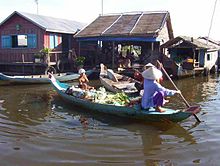
Back Kamboca vyetnamlıları Azerbaijani Orang Vietnam di Kamboja ID ជនជាតិខ្មែរវៀតណាម Cambodian Người Campuchia gốc Việt Vietnamese 越南裔柬埔寨人 Chinese
 A Vietnamese floating village in Siem Reap | |
| Total population | |
|---|---|
| 180,000–1,000,000 (est.) 1% - 6.25% of the Cambodian population[1] | |
| Regions with significant populations | |
| Siem Reap, Phnom Penh, South-East Cambodia | |
| Languages | |
| Vietnamese, Khmer | |
| Religion | |
| Vietnamese folk religion, Mahayana Buddhism, Theravada Buddhism, Caodaism, Roman Catholicism | |
| Related ethnic groups | |
| Overseas Vietnamese, Austroasiatic peoples |
Vietnamese Cambodians refers to ethnic group of Vietnamese who live in Cambodia or it refers to Vietnamese who are of full or partial Khmer descent (the Native Khmer in Mekong delta, Vietnam nowadays, also often called as Khmer Krom, or Khmer Mekong). According to Cambodian sources, in 2013, about 15,000 Vietnamese people live in Cambodia. A Vietnamese source stated that 156,000 people live in Cambodia,[2] while the actual number could be somewhere between 400,000 and one million people, according to independent scholars.[3] They mostly reside in southeastern parts of Cambodia bordering Vietnam or on houseboats in the Tonlé Sap lake and Mekong rivers. The first Vietnamese came to settle modern-day Cambodia from the early 19th century during the era of the Nguyễn lords and most of the Vietnamese came to Cambodia during the periods of French colonial administration and the People's Republic of Kampuchea administration. During the Khmer Republic and Khmer Rouge governments in the 1970s under the Pol Pot regime, the Vietnamese among others were targets of mass genocides; thousands of Vietnamese were killed and many more sought refuge in Vietnam.
Ethnic relations between Cambodians and Vietnamese are complex. Despite engagement and collaboration between the two countries, Vietnamese individuals have been the targets of xenophobic attacks by opposition political parties critical of Hun Sen's policies since the 1990s.[4] Many of the stateless Vietnamese residents face difficulties in getting access to education, employment, and housing.[5][6] Although xenophobic sentiments have been a continuing source of concern, they have not been a barrier towards neighborly ties within the context of Southeast Asia and other international affairs.[7][8][4][9]
- ^ "'Please show mercy': Evicted by Cambodia, ethnic Vietnamese stuck at watery border". Reuters. 2 July 2021.
- ^ "VN phối hợp với Campuchia đảm bảo cuộc sống người Việt". Ngày Nay. 23 September 2016.
- ^ "A People in Limbo, Many Living Entirely on the Water". The New York Times. 2018-03-28.
- ^ a b Heng, Kimkong (2022-04-12). "2022/36 "Cambodia-Vietnam Relations: Key Issues and the Way Forward" by Kimkong Heng".
- ^ "Cambodia at a Glance" (PDF). asiafoundation.org.
- ^ Christ, Kiernan (2022-06-14). "The Perpetual Foreigner: Statelessness among the Vietnamese Minority in Cambodia". Georgetown Journal of International Affairs. Retrieved 2023-07-30.
- ^ VnExpress. "Vietnam, Cambodia to further strengthen multifaceted relations - VnExpress International". VnExpress International – Latest news, business, travel and analysis from Vietnam. Retrieved 2023-07-30.
- ^ "Cambodia-Vietnam, a true friendship in ASEAN context - Khmer Times". 2022-11-13. Retrieved 2023-07-30.
- ^ "Dialogue on War Legacies and Peace in Vietnam, Laos and Cambodia". United States Institute of Peace. Retrieved 2023-07-30.